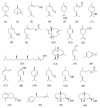Essential Oils from the Malaysian Citrus (Rutaceae) Medicinal Plants
- PMID: 28930124
- PMCID: PMC5456223
- DOI: 10.3390/medicines3020013
Essential Oils from the Malaysian Citrus (Rutaceae) Medicinal Plants
Abstract
This review article appraises the extraction methods, compositions, and bioactivities of the essential oils from the Citrus species (family: Rutaceae) endemic to Malaysia including C. aurantifolia, C. grandis, C. hystrix, and C. microcarpa. Generally, the fresh peels and leaves of the Citrus species were extracted using different methods such as steam and water distillation, Likens-Nikerson extraction, solvent extraction, and headspace solid-phase micro-extraction (HS-SPME). Most of the Citrus oils were found to be rich in monoterpene hydrocarbons with limonene (1) as the major component identified in the peels of C. aurantifolia (39.3%), C. grandis (81.6%-96.9%), and C. microcarpa (94.0%), while sabinene (19) was the major component in the peels of C. hystrix (36.4%-48.5%). In addition, citronellal (20) (61.7%-72.5%), linalool (18) (56.5%), and hedycaryol (23) (19.0%) were identified as the major components in the oil of C. hystrix leaves, C. grandis blossom and C. microcarpa leaves, respectively. The C. hystrix essential oil has been experimentally shown to have antimicrobial and antifeedant activities, while no bioactivity study has been reported on the essential oils of other Malaysian Citrus species.
Keywords: Citrus; Rutaceae; bioactivities; composition; essential oils; extraction.
Conflict of interest statement
The authors declare no conflict of interest.
Figures





Similar articles
-
Phytochemical Composition, Antioxidant and Antiproliferative Activities of Citrus hystrix, Citrus limon, Citrus pyriformis, and Citrus microcarpa Leaf Essential Oils against Human Cervical Cancer Cell Line.Plants (Basel). 2022 Dec 27;12(1):134. doi: 10.3390/plants12010134. Plants (Basel). 2022. PMID: 36616263 Free PMC article.
-
Composition and Bioactivity of Essential Oil from Citrus grandis (L.) Osbeck 'Mato Peiyu' Leaf.Molecules. 2017 Dec 5;22(12):2154. doi: 10.3390/molecules22122154. Molecules. 2017. PMID: 29206180 Free PMC article.
-
Insights into the chemical composition and bioactivities of citrus peel essential oils.Food Res Int. 2021 May;143:110231. doi: 10.1016/j.foodres.2021.110231. Epub 2021 Feb 27. Food Res Int. 2021. PMID: 33992345 Review.
-
Chemical composition and antimicrobial activity of the essential oils from New Caledonian Citrus macroptera and Citrus hystrix.Chem Biodivers. 2010 Apr;7(4):871-7. doi: 10.1002/cbdv.200900196. Chem Biodivers. 2010. PMID: 20397222
-
Health-Promoting Properties and Potential Application in the Food Industry of Citrus medica L. and Citrus × clementina Hort. Ex Tan. Essential Oils and Their Main Constituents.Plants (Basel). 2023 Feb 21;12(5):991. doi: 10.3390/plants12050991. Plants (Basel). 2023. PMID: 36903853 Free PMC article. Review.
Cited by
-
Agro-Physiological Traits of Kaffir Lime in Response to Pruning and Nitrogen Fertilizer under Mild Shading.Plants (Basel). 2023 Mar 3;12(5):1155. doi: 10.3390/plants12051155. Plants (Basel). 2023. PMID: 36904015 Free PMC article.
-
Potential Therapeutic Effects of Citrus hystrix DC and Its Bioactive Compounds on Metabolic Disorders.Pharmaceuticals (Basel). 2022 Jan 29;15(2):167. doi: 10.3390/ph15020167. Pharmaceuticals (Basel). 2022. PMID: 35215280 Free PMC article. Review.
-
Elucidation of the composition, antioxidant, and antimicrobial properties of essential oil and extract from Citrus aurantifolia (Christm.) Swingle peel.Saudi J Biol Sci. 2024 Jun;31(6):103987. doi: 10.1016/j.sjbs.2024.103987. Epub 2024 Apr 5. Saudi J Biol Sci. 2024. PMID: 38617568 Free PMC article.
-
Morphology Characterization, Molecular Identification, and Pathogenicity of Fungal Pathogen Causing Kaffir Lime Leaf Blight in Northern Thailand.Plants (Basel). 2022 Jan 20;11(3):273. doi: 10.3390/plants11030273. Plants (Basel). 2022. PMID: 35161253 Free PMC article.
-
A cleaner and eco-friendly approach to simultaneous extraction and characterization of essential oil and pectin from Assam lemon peel and its application for energy generation through TENG devices.Heliyon. 2024 Jul 18;10(15):e32999. doi: 10.1016/j.heliyon.2024.e32999. eCollection 2024 Aug 15. Heliyon. 2024. PMID: 39165985 Free PMC article.
References
-
- Manner H.I., Buker R.S., Smith V.E., Ward D., Elevitch C.R. Citrus (citrus) and Fortunella (kumquat) Species Profile Pac. Isl. Agrofor. 2006;2:1–35.
-
- Ng D.S.H., Rose L.C., Suhaimi H., Mohammad H., Rozaini M.Z.H., Taib M. Preliminary evaluation on the antibacterial activities of Citrus hystrix oil emulsions stabilized by tween 80 and span 80. Int. J. Pharm. Pharm. Sci. 2011;3:209–211.
-
- Jantan I., Ahmad A.S., Ahmad A.R., Ali N.A.M., Ayop N. Chemical composition of some Citrus oils from Malaysia. J. Essent. Oil Res. 1996;8:627–632. doi: 10.1080/10412905.1996.9701030. - DOI
-
- Nor O.M. Sebatian aroma dalam minyak Citrus grandis (Aromatic compounds from Citrus grandis Oil) J. Trop. Agric. Food Sci. 1999;27:231–236.
-
- Cheong M.-W., Loke X.-Q., Liu S.-Q., Pramudya K., Curran P., Yu B. Characterization of volatile compounds and aroma profiles of Malaysian pomelo (Citrus grandis (L.) Osbeck) blossom and peel. J. Essent. Oil Res. 2011;23:34–44. doi: 10.1080/10412905.2011.9712279. - DOI
Publication types
LinkOut - more resources
Full Text Sources
Other Literature Sources

